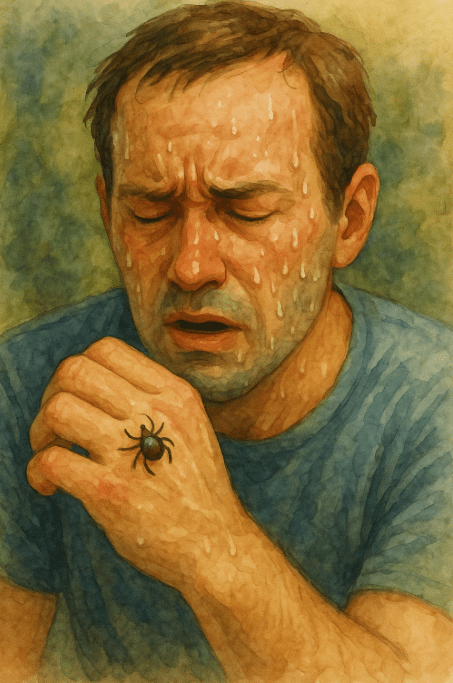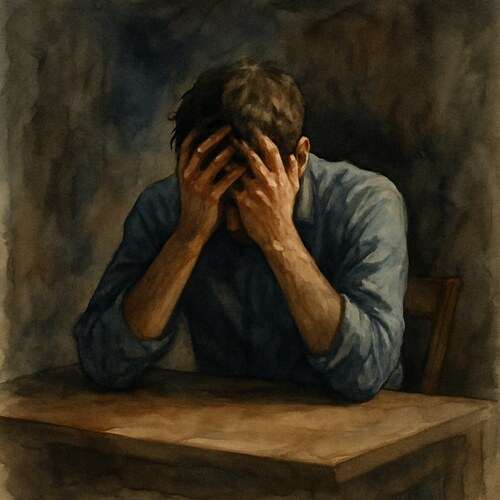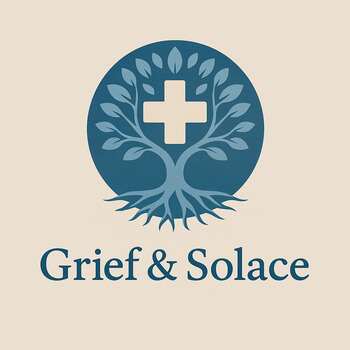Grieving Lyme Disease: Mourning the Life That Disappeared Without Warning
Grief tied to Lyme disease is quiet and cruel, watching energy fade, dreams stall, and strength wither away under an invisible weight.

This post blends real grief with grounded knowledge. It isn’t clinical. It isn’t distant. It’s meant to sit beside you—not above you. The story you’ll read is meant to reflect what so many feel when living through or witnessing this condition: confusion, exhaustion, and quiet forms of courage.
If what you read feels familiar, please speak with your doctor. Your pain deserves more than silence.
We Lost Him in Pieces Before Anyone Believed It Was Real
It all began with a small, unnoticed rash. Just a faint red spot on his thigh, not quite a bullseye, not enough to raise alarm. He figured it might be a spider bite or perhaps some irritating poison ivy from a hike over the weekend. He scratched it, brushed it off, and moved on.
Then came the fatigue, an all-encompassing weariness that even sleep couldn’t alleviate. Soon, headaches followed, accompanied by aching joints and a brain fog so dense that he forgotten his coffee perched on the roof of the car, twice, in a week.
Others suggested he was simply stressing out. They whispered about possible depression or dismissed it as the inevitable toll of aging, like turning thirty was some sort of cliff to tumble over.
🧠 Symptoms:
stage_1 (early localized):
– Single expanding rash (bull’s-eye appearance)
– Fever
– Headache
– Fatigue
– Joint stiffness
– Muscle aches
– Swollen lymph nodes
stage_2 (early disseminated):
– Multiple rashes
– Neck stiffness or pain
– Facial paralysis (Bell’s palsy)
– Irregular heart rhythm
– Pain/numbness in limbs
– Vision issues or eye inflammation
– Pain starting in lower back or hips and spreading to legs
stage_3 (late disseminated):
– Arthritis, especially in the knees
– Swelling and chronic joint pain
– Neurological problems (numbness, tingling, memory loss)
– Chronic fatigue
– Acrodermatitis chronica atrophicans (in European cases)
But I witnessed it…the slow decline, the gradual unraveling of a once-vibrant man who used to run trails at dawn and could now barely recall where he’d set his keys or why he entered a room.
We pleaded for answers. The doctor was skeptical at first, his blood tests returning with “normal” results. Even that initial Lyme test? Negative.
They insisted it was all in his mind.
Yet his body had a different story to tell.
By the time they finally detected the antibodies, after a second test, they should have performed much sooner; he had already been suffering for months.
Lyme disease. A single bite. One tick. One fleeting moment in the woods, and it transformed everything.
The antibiotics arrived late. They offered some relief, but not completely. While some symptoms faded, others stubbornly remained.
Complications:
– Chronic arthritis
– Neuropathy
– Memory and concentration problems
– Post-Treatment Lyme Disease Syndrome (PTLDS)
– Persistent fatigue and joint/muscle pain
– Potential autoimmune responses
Causes:
– Caused by *Borrelia burgdorferi* (North America) or *Borrelia afzelii/garinii* (Europe)
– Transmitted via infected deer ticks (black-legged ticks)
– Bacteria typically require 24+ hours to transmit once tick attaches
He lost pieces of himself in inexplicable ways: his balance, his short-term memory, and his trust in his own body.
The most painful aspect was not the physical discomfort; it was the disbelief that surrounded him. The need to continuously prove his illness, to repeatedly ask for help in a world that simply saw, “You look fine to me.”
We lost him gradually, not in sudden chaos, but slowly, a little more with each passing day.
When we finally attached a name to his condition, there was no sense of relief; only an overwhelming sense of grief.
Risk Factors:
– Living or visiting wooded or grassy regions (Northeast, Midwest U.S.; parts of Canada & Europe)
– Outdoor activities (hiking, camping, gardening)
– Warmer seasons (spring to fall, when ticks are most active)
– Failing to detect or remove ticks within 24 hours
Grief for the man he used to be. Grief for the time lost to doubt. Grief for how long it took for anyone to truly listen.
He’s still here, still fighting to rebuild. He’s still taking vitamins, tracking symptoms, and researching his flare-ups.
Yet, he walks differently now…with caution, with wisdom, bearing the knowledge that sometimes, it’s not the illness that breaks you; it’s the silence that surrounds it.
The tick was small, the bite nearly invisible…but the silence that followed? That’s what really caused the harm.
📘 Diagnosis & Treatment
diagnosis:
– Based on symptoms, tick exposure, and physical exam
– Classic rash may suffice for early diagnosis in endemic areas
– Blood tests for antibodies (may be negative early)
– ELISA followed by Western blot (confirmatory testing)
– Lumbar puncture or heart monitoring if CNS/heart involvement suspected
treatment:
antibiotic pills:
– Doxycycline, amoxicillin, or cefuroxime (10–21 day course)
– Early treatment leads to full recovery in most cases
iv antibiotics:
– Used in severe cases (e.g., neurological or cardiac involvement)
– Typically 14–28 days
post treatment support:
– PTLDS symptoms managed with supportive care (pain relief, rest)
– Continued antibiotics are not effective once bacteria are cleared
prevention:
clothing and gear:
– Wear long sleeves, pants, and socks tucked in
– Treat clothes/gear with permethrin
– Use EPA-approved insect repellents (DEET, picaridin, PMD)
self-checks:
– Shower and check entire body after being outdoors
– Inspect scalp, ears, underarms, groin, knees, bellybutton
– Dry clothes on high heat for 10+ minutes to kill ticks
tick removal:
– Use fine-tipped tweezers to grasp tick near skin
– Pull upward steadily—don’t twist or crush
– Disinfect area and save tick for possible testing
environment:
– Avoid high grasses and wooded areas with dense brush
– Stick to trails and wear protective gear
I know this is heavy, and I understand that the road ahead may feel like a tangle of loss and unanswered questions. But please hear this: you are not broken because you are hurting; you are not weak because you are afraid. You are living through something real, and survival itself is a kind of grace. You are allowed to struggle, you are allowed to hope, and you are allowed to not have all the answers today. Whatever comes next, you do not face it empty-handed; you carry every moment of love that shaped you, and that will always be enough to keep going.
🎀 Gifts to help With Lyme Disease
🏥 Everyday Comforts for Everyday Battles
Managing Lyme Disease often means needing a little extra help.
Sometimes it’s about restoring dignity, ease, or simply getting through the day with less pain.
These carefully chosen tools aren’t just items; they’re small bridges back to living.
This section is about finding practical support, never shame.
Joint + Nerve Comfort Wrap – Relief for the Pain That Moves Without Warning
Lyme pain is slippery. One day it’s your knees. The next, your spine or hands. This microwavable wrap flexes and contours to wherever the ache lands, offering heat or cold to soothe inflammation, stiffness, and nerve zaps. A flexible ally for a condition that doesn’t stay in one place.
🌿 Paths to Healing Beyond the Map
Sometimes traditional medicine isn’t enough.
If you’re exploring gentle, alternative options to help with Lyme Disease,
you might find comfort in plant-based compounds like **CBD or CBG**.
*This section is not medical advice, just a door left open.*
USA Medical Total Support Pack – Help for the Body That Still Feels Infected
Even after antibiotics, Lyme can leave behind fatigue, immune dysregulation, and cognitive fog. This Total Pack combines CBD, adaptogens, immune support, and sleep aid to support recovery from the inside out. It’s not a cure. But it may help a body that still feels like it’s fighting ghosts.
Need a Different Path Forward?
Every journey through grief looks different. Choose the next step that speaks to where you are now:
When You're Ready to Start Healing
Healing doesn’t mean forgetting.
It means finding small ways to carry your grief with strength and grace.
These are the stories, tools, and gentle steps to begin walking forward…at your own pace.
When You're Still in the Thick of It
Sometimes healing feels like a lie.
If you’re not ready to move on…if the pain still roars louder than the world wants to hear…this is the place where you’re allowed to feel it.
No sugarcoating. No pretending. Just truth.
When You're Holding on to Who’s Still Here
Grief reminds us to love louder.
If someone you love is still with you, this is your place to celebrate them, honor them, and create new memories while there’s still time.
Joy and sorrow can live side by side.






